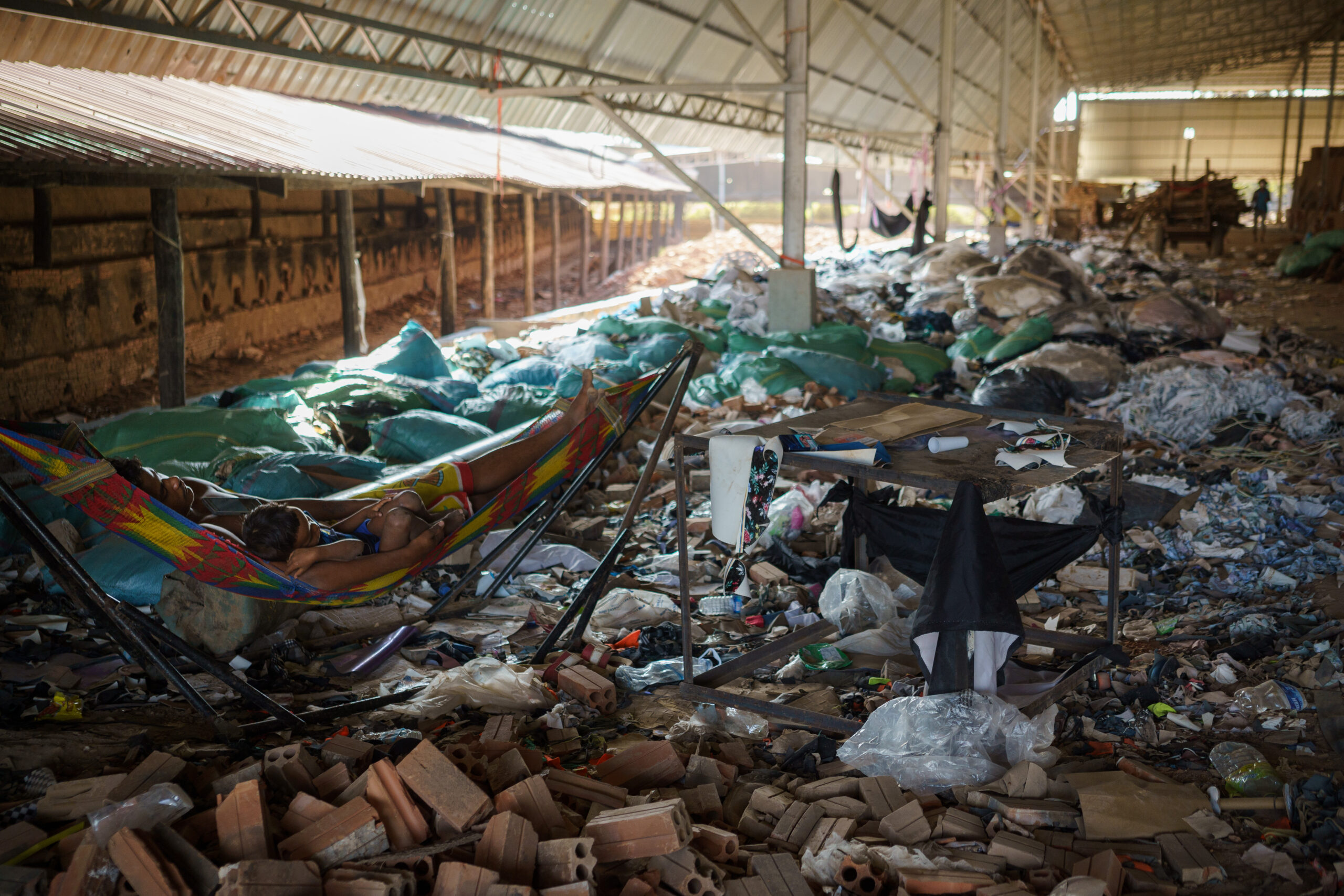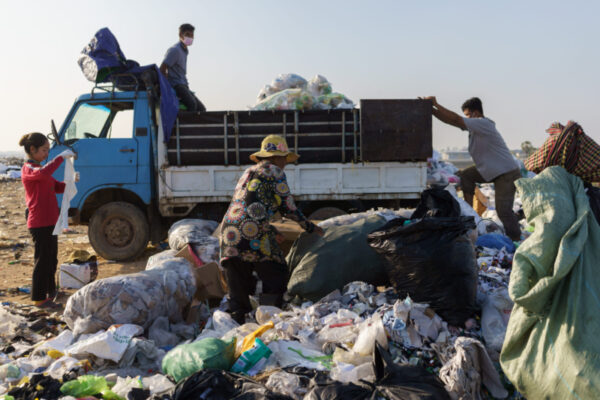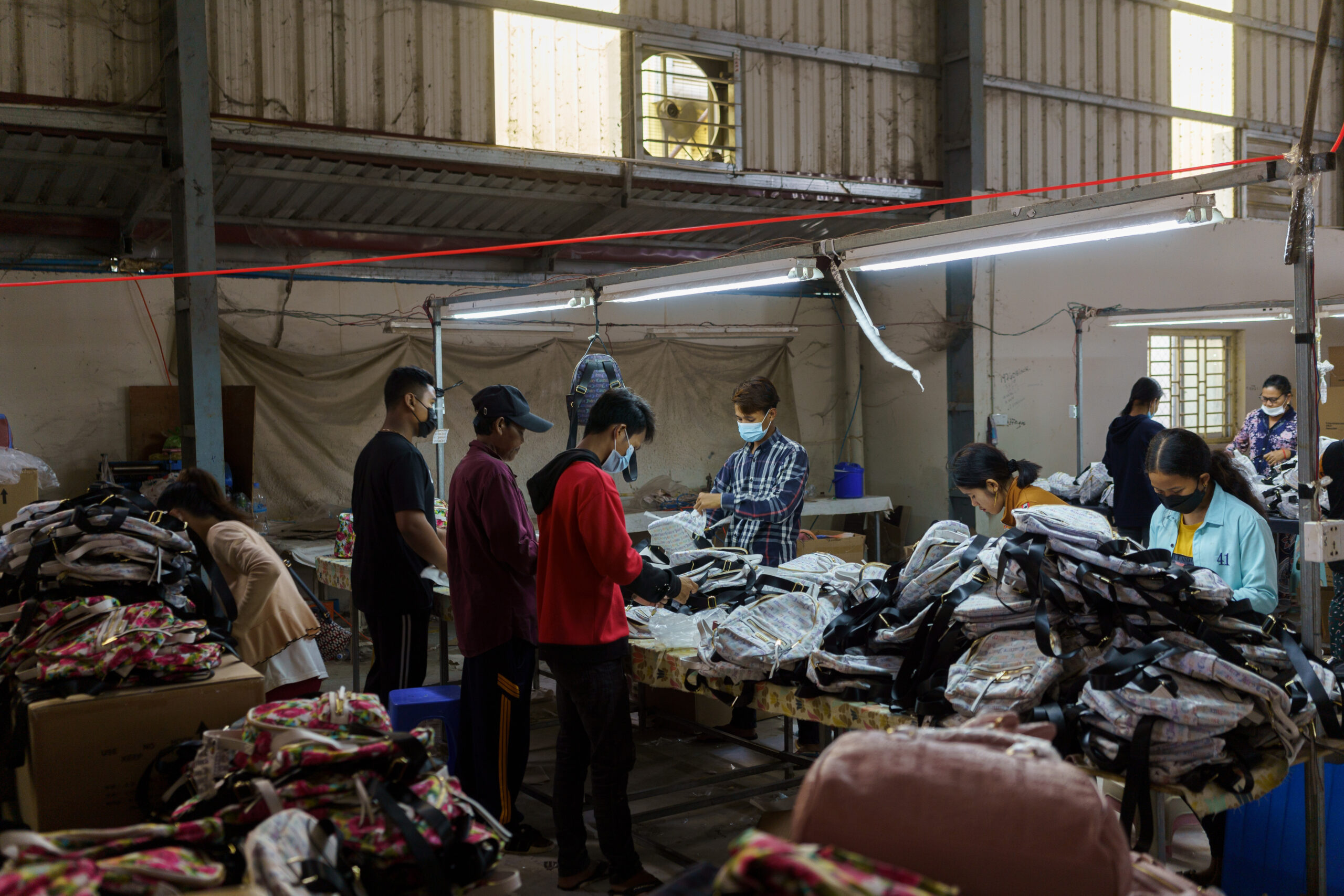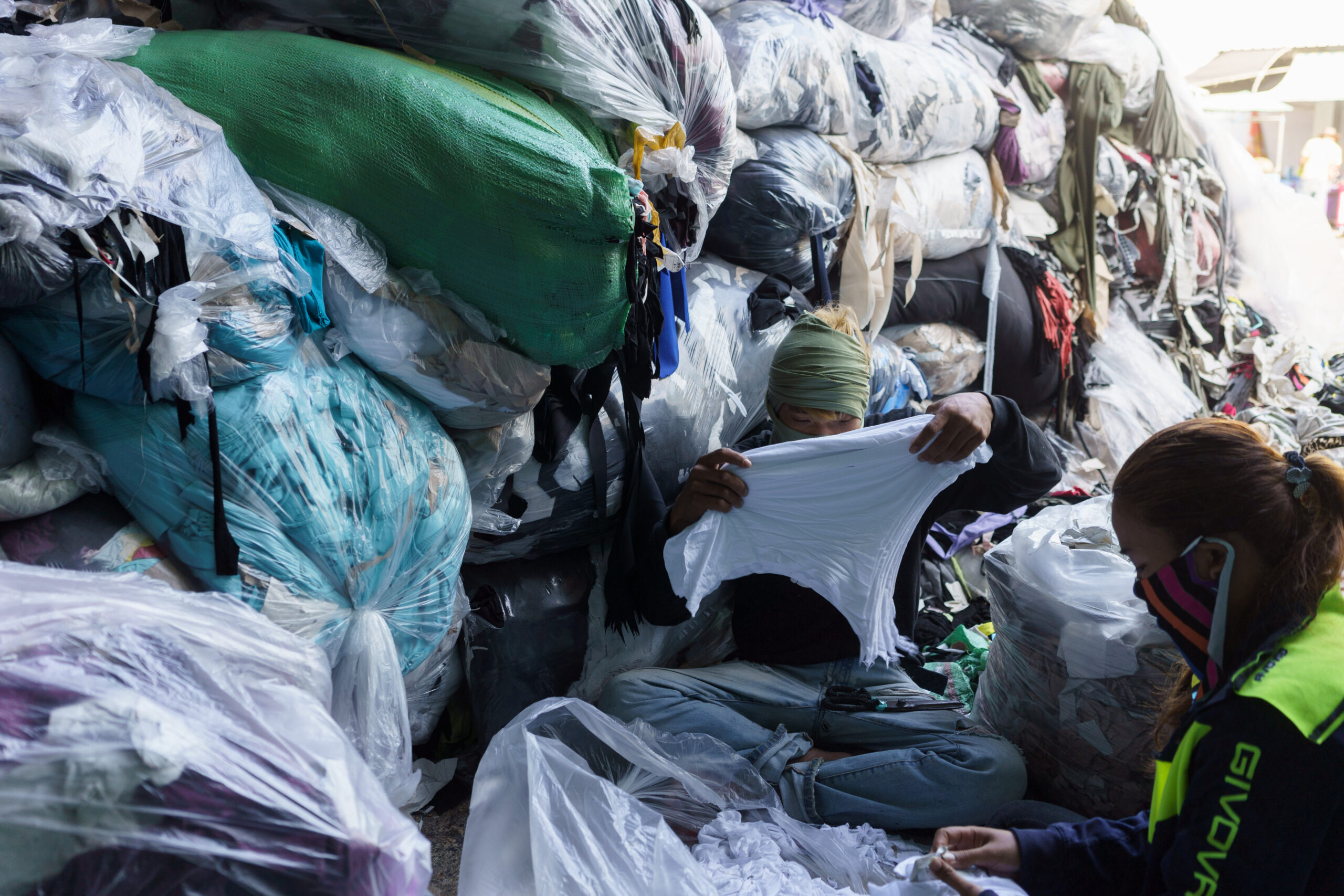
A woman loads garment offcuts into a brick kiln located in Kandal province. Photo: Thomas Cristofoletti / Ruom for Unearthed
Revealed: Garment waste from Nike, Clarks and other leading brands burned to fuel toxic kilns in Cambodia
Off-cuts from Cambodian clothing factories that supply leading western brands, including Ralph Lauren and Michael Kors, are being used to fuel brick-kilns - exposing bonded workers to toxic fumes
Revealed: Garment waste from Nike, Clarks and other leading brands burned to fuel toxic kilns in Cambodia
Off-cuts from Cambodian clothing factories that supply leading western brands, including Ralph Lauren and Michael Kors, are being used to fuel brick-kilns - exposing bonded workers to toxic fumes
A woman loads garment offcuts into a brick kiln located in Kandal province. Photo: Thomas Cristofoletti / Ruom for Unearthed
An Unearthed investigation has revealed how off-cuts from Cambodian factories supplying major brands are being used to fuel brick kilns – exposing workers to toxic fumes.
Our investigation found tags, labels, footwear, fabric and garment scraps from Nike, Ralph Lauren, Michael Kors, Reebok, Next, Diesel, and Clarks at five different kilns alongside evidence that kilns were using garment waste in their fires.

To manufacture bricks workers move dried slabs of clay by hand into the kilns, where they burn for a couple of days in temperatures reaching up to 650°C. To maintain such heat, the kilns need to stay fired, and workers burn fuel – in some instances a mix of garment waste and wood – around the clock.
Often associated with plumes of black, choking smoke, the incineration of garment waste, which commonly contains toxic chemicals, endangers the health of vulnerable kiln workers. Reported health impacts include coughs, colds, flus, nose bleeds and lung inflammation.

It is also exacerbating the carbon footprint of clothes destined for Europe and the US, despite commitments to cut emissions from clothing manufacturers.
“The burning of acrylic garments, especially when combined with plastic bags, hangers, rubber and other waste as occurs in Cambodia, releases plastic microfibres and other toxic chemicals into the immediate environment which compromise the health of workers and neighbours on a short and long term basis. The human impacts, in particular, are substantially worse than burning wood and have been highlighted in a recent UK parliamentary report as a major problem in the industry,” says Dr Laurie Parsons of UK’s Royal Holloway University. Parsons co-authored a seminal 2018 report exposing the practice of garment incineration in Cambodian kilns.

Major brands said that burning garment waste in this way would be against their protocols, that the claims would be investigated and that they expected their partners and suppliers to comply with strict codes of practice.
A Clarks spokesperson stated “we are conducting a thorough investigation and believe we have identified the potential source. We believe this incident to be an exceptional occurrence. Our ongoing investigation has led us to believe that in accordance with our code of practice for suppliers, waste from the relevant Cambodian factories was provided to a government-approved waste services company.”
A Michael Kors spokesperson added “we strive to produce our products in an environmentally responsible manner, and to partner with suppliers to reduce emissions, waste and other environmental impacts of our products” and “will reiterate to our suppliers our expectations around proper collection and disposal of garment waste.”
When communicating with Next – we asked how and why their products ended up in a local brick kiln. A Next spokesperson answered “under clause 8.5 of the Next Standard Terms and Conditions of Purchase, suppliers cannot dispose of rejected, seconds, excess, samples or cancelled stock unless stock is sold through the Next clearance routes” and that “it appears this breach could possibly have taken place due to their suppliers in Cambodia not adhering to the policy.”
OTB Group, the parent organisation for Diesel, explained that “OTB constantly monitors the supply chain” and “the brand is no longer producing garments in Cambodia at the moment.” They added, “no evidence has emerged on the subject from the recent internal review we carried out with our former and only supplier active in the Country in 2020/2021.”
Video: Marta Kasztelan, Sam Quashie-Idun, Ali Deacon and Thomas Cristofoletti
Climate impacts and modern slavery
The Cambodian brick sector, which had been feeding Cambodia’s construction boom until the Covid-19 pandemic, has become infamous for human rights abuses, including debt-bondage – half of all victims of forced labour are trapped in debt bondage according to the International Labour Organisation (ILO). In 2016, the organisation estimated that worldwide 16 million people were subjected to forced labour by private entities.
Many kiln workers are ex farmers, who took out microfinance loans to meet farming expenses and whose crops failed because of unpredictable weather patterns caused by climate change, according to Dr Laurie Parsons of UK’s Royal Holloway University.
“You get people who end up with a load of debt, no income. And they’ve got no choice essentially, but to try to consolidate those debts by selling them in effect to the brick kiln owner who pays off all of their debts and says ‘now you owe me this money. You’re going to work for me until that debt is paid off,’” he says.
To farmers who have few employment options, the loans offered by kiln owners seem reasonable because they are interest-free. But often, entire families end up trapped for years in intergenerational debt bondage, with children taking over the parents’ debt after their loved ones pass, the report found.
21-year-old Samneang, whose name was changed to protect his identity, has been helping pay off his parents’ $2,000 USD debt since he turned 15. Two decades ago, his five-person family migrated to work at the kiln in Kandal province, north of the capital Phnom Penh. With a hefty debt following too many failed rice harvests, they have been working here ever since.
Impact of the Covid-19 pandemic
“Life has become more difficult since the pandemic started,” the young man said when we spoke to him at the beginning of the year. Prior to the pandemic, he used to earn up to $230 USD a month. In 2021, his already meagre wages shrunk as orders dried up due to the pandemic-spurred economic slowdown. This is also when his kiln owner began feuling kiln fires with garment waste.
Until a year ago, Samneang says, wood and rice husks were the primary source of fuel. “The kilns burn garments for fuel. About two to three trucks per day come regularly,” he explains. “When they burn garments, it gets smoky. It’s unhealthy for us.”
His health seems to have suffered already – he has since borrowed an additional US $400 from the kiln owner, partly for medical expenses. “I feel unwell quite often and have fever and colds more frequently these days. I have nosebleeds between two and three times per month” says the soft-spoken youth whose father, also a kiln worker, passed away last year at the age of 51.
While kiln fires are predominantly fueled by wood, a 2020 survey conducted by a local union and Royal Holloway found that 23 out of 465 kilns burnt garment waste. “And they were in most cases burning several tons a day. So we’re looking at hundreds of tons of garments being burned every day,” Parsons tells Unearthed.
At the time, over 10,000 individuals were declared to have resided at kilns scattered across the country, of which almost 7,000 confirmed they were employed by the brick industry. Workers usually migrate with their families and live on site.
Between December 2021 and January 2022, Unearthed discovered that some kilns shut down while others started incinerating garment waste, as it is substantially cheaper than wood. The economic slowdown decimated brick orders and lowered prices, forcing some establishments to burn garment and textile waste to survive, according to the kiln owners and workers we interviewed.

The exact number of kilns currently strictly incinerating garment waste or a mix of garment waste and wood remains unknown.
“What’s concerning us is that the number of brick kilns burning garments would have increased because wood is expensive and they are running out of it,” says Sou Chhloung, the deputy director of Building and Wood Workers Trade Union Federation of Cambodia (BWTUC). He has been spearheading efforts to unionise brick makers around the country for years and is particularly concerned about their health.
Dara, whose name was changed to protect his identity, has been a kiln owner for fourteen years and employs up to 40 people, all indebted to him. He told Unearthed that although health impacts were of concern to him, he too started burning garments in 2021 to make up for his losses.
“Before the pandemic, I never used garment waste in my kiln. Wood and other materials are more expensive than fabric waste” he added.
A small truck of garment waste, which Dara says he only uses to kindle the fire, costs US $100. Whereas a large truck of wood costs between $1,000 to $1,500 USD
“I normally call the middlemen to get me garment waste. I don’t know the origins of that fabric waste though, ” he says. “They come to my kiln and sell the fabric waste to us.”

Some kiln owners in Kandal province – Dara included – told Unearthed that Ministry of Environment officials instructed them to stop burning garment waste last year. To date nobody has been held accountable, according to ministry spokesperson Neth Pheaktra.
According to a sub-decree on waste management, industries burning solid waste – which includes garment and fabric scraps – can be fined $250 USD. Another sub-decree warrants inspection by the Ministry of Environment where pollution endangers human health or the environment. Pollution that endangers “human bodies or lives” appears to be a violation of Cambodia’s environmental law, which stipulates over $12,000 USD in fines and five years imprisonment for the most egregious offenders.
Garment waste supply chain
Officially, apparel and footwear factories supplying some of the world’s beloved brands predominantly dispose of their garment and textile waste at a landfill or elsewhere through licensed waste disposal companies. However, a thriving unregulated garment waste industry means that some of it ends up at the kilns.
A 2021 report by German development organisation GIZ shows it gets to Kilns through a web of middlemen purchasing garment waste directly from factories and selling it to truck drivers who deliver to Kilns. A truck of garment waste purchased directly from a factory manager costs just $60 USD, one middleman supplying kilns who refused to provide his name, told Unearthed.
Other means of sourcing garment waste reportedly include intercepting trucks with waste on their way to the landfill. Unearthed also spoke to two truck drivers supplying kilns who said they picked up garment waste directly from factories.

With such a complex supply chain, it is difficult to pin the garments’ source or journey step by step. Based on the Open Apparel registry, Unearthed was able to connect a Ralph Lauren supplier to a kiln, burning garment waste, where a factory order sheet and labels from Polo Ralph Lauren were found near bags with garment waste. The firm failed to respond to repeated and acknowledged requests for comment.
Separately, the Ministry of Environment confirmed to Unearthed that since 2017 one garment factory was fined for “improper solid waste disposal” but it is unclear what that disposal entailed. The spokesperson did not respond to requests for further clarification.
The global fashion brands and their sustainability targets
Some of the brands whose labels, fabric, clothing and footwear scraps Unearthed found at the kilns incinerating garment waste have committed to ambitious social and environmental sustainability targets in their operations. They have anti-modern slavery statements and pledges pertaining to eliminating waste and carbon emissions in their supply chain.
Nike made a splash in 2019 when it dropped its “Move to Zero” campaign around the same time the youth-led Global Climate strike rocked the streets of New York. “Our priority is zero waste, period,” Nike says on its website. This includes diverting 100% of waste from landfill in Nike’s supply chain and zero carbon emissions — meaning they’ll be at or below 2020 levels — from key suppliers by 2025.
“Examples include not allowing open disposal to land or water, improper disposal of waste by products such as incinerator ash or leachate or uncontrolled burning or emissions,” Nike’s code leadership standards say.
Nike, Ralph Lauren, Michael Kors, Reebok, Next, Clarks and Diesel also have supplier codes of conduct, which at the very minimum require factories in Cambodia to respect local environmental laws and dispose of waste in line with applicable regulations. Nike requires their suppliers “verify that they exercise responsible environmental management practices.”

Similarly, Clarks states that their suppliers need to respect applicable environmental laws and “must have effective systems for waste management that prevent any pollution or detrimental impact on communities and maximise the recycling of waste where it is possible.”
The company told Unearthed “We have strict codes of practice…we expect our partners and suppliers to comply with these policies and practices, and we conduct regular and rigorous audits throughout our supply chain to ensure this is the case. What is alleged goes against our values as a business, our policies, and our business practices.”
In reality, experts say, brands are free to make sweeping commitments because there is no legal framework or oversight body that could hold them accountable for what’s happening in their supply chain.
“In the absence of clear legislative oversight, what a lot of brands do is they make specific public commitments about sustainability in their supply chain,” says Royal Holloway’s Parsons.
But for a few, most fashion brands producing clothes and footwear in Cambodia don’t have any physical presence in the country, rendering meaningful oversight difficult, Parsons says. “Brands can essentially say to some extent what they want, and the only thing which is going to discern whether or not that’s not correct is independent reporting.”

How we found the evidence
Between December 2021 and January 2022, Unearthed found garment waste from some of the world’s leading brands at 5 kilns, scattered across kiln clusters in the southeastern Kandal province.
We began our journey north of Phnom Penh, where we first visited a small-sized kiln and identified garment waste for Reebok – a black strip of material with the Reebok logo across it. We found it near the kiln ovens, among the brick debris lying on the ground. We then travelled to a medium-sized kiln where we found Polo Ralph Lauren labels scattered near kiln ovens and a bag containing garment waste. Continuing our journey northwards of the capital, we came across another kiln, where we found piles of bags stuffed with garment waste. Here, we identified a number of labels from Next and a Diesel label scattered on the ground near the bags.

During our second round of kiln visits in Kandal province on 12 January 2022, we identified further garment waste at three brick kilns. At the first kiln – the same one where we identified Reebok waste earlier – we found what appears to be garment waste from bags – with the Michael Kors logo on them – as well as stickers containing QR codes with the words Michael Kors printed on them. The waste was situated between lines of drying bricks and ovens on the kiln premises.

We continued on to the next kiln cluster, where we found a number of dishevelled Nike garments at a sprawling kiln in bags stuffed with garment and fabric waste. We then travelled to another kiln in the same area and found shoe remnants from Clarks, among piles of garment waste and bags containing garment waste. At both kilns, we witnessed workers fueling the kilns with the garment waste.



During both field trips, Unearthed witnessed workers using bags of garment waste to fuel the kiln ovens.
We reached out to Nike and Ralph Lauren but they didn’t respond to multiple requests for comment.
Right of replies
A NEXT spokesperson said: “As part of contractual obligation the suppliers to NEXT have to adhere to our Disposal Policy. An extract of which states: – Under clause 8.5 of the Next Standard Terms and Conditions of Purchase, Suppliers CANNOT dispose of rejected, seconds, excess, samples or cancelled stock UNLESS stock is sold through the Next authorised Clearance routes (Next Clearance and Choice). This includes stock which has been produced but not shipped to Next.
It appears from your email that this breach could possibly have taken place due to our supplier(s) in Cambodia not adhering to the above policy. In this incident , can we please ask to share any further details ( photos of our branding / item number / contract number ) that you have found during the course of your investigation, so we can trace it to the relevant supplier.
We communicate our policies with our contracted suppliers and reiterate the importance of adherence to the standards . These form part of our contractual terms and conditions with suppliers. Our directly employed ethical teams on the ground regularly monitor our contracted factories to ensure adherence to our ethical standards, however we also understand the challenges of tracing and tracking the offcuts to a particular supplier but in cases where we have tracked it, necessary actions have been taken.
NEXT is a active member of SAC (Sustainable Apparel Coalition ) which is an alliance of over 250 leading apparel, footwear and textile brands, retailers, suppliers, service providers, trade associations, non-profits, NGOs, and academic institutions working to reduce environmental impact and promote social justice throughout the global value chain. NEXT recognises the value of in-country legislation, which would help support the responsible management of textile waste by the textile industry to encourage re-use of the materials into new fibres and fabrics wherever possible.”
Diesel’s parent company OTB explained: “OTB constantly monitors the supply chain and applies, alongside its brands and companies, a specific Code of Conduct to all Group suppliers worldwide. This agreement provides specific rules in terms of compliance with all applicable environmental laws and also requests all suppliers to implement processes and systems to reduce the use of natural resources such as water and energy, and to minimise waste.
The respect of the Code of Conduct and of the local regulations are the conditions to start a collaboration between the Group’s brands and the suppliers globally.
Diesel already launched an in-depth internal review to better verify the situation with its former suppliers in the Country, since the brand is no longer producing garments in Cambodia at the moment.
Looking at the future, we strongly encourage a national and local regulation on the topic, which could support the brands and the suppliers in having a clear framework to work together to increasingly minimise the impact of the garment production.”
They later added: “While reiterating that OTB constantly monitors the supply chain, which has to apply to the specific Code of Conduct and to all applicable environmental laws, we confirm that Diesel currently has no garments production and no business relationships with suppliers in Cambodia. Moreover, we confirm that no evidence has emerged on the subject from the recent internal review we carried out with our former and only supplier active in the Country in 2020/2021.
Following our standard, we also regularly visit our suppliers factories to verify that all audit information reflect the current conditions; unfortunately due to pandemic travel restriction we could not travel in Cambodia and we relied on third party audit reports and information.
We take very seriously any issue of this nature and we welcome any further evidence you are able to share with us. This will help us to further contextualise the case you are referring to. Unfortunately we know that in Cambodia there is also an active counterfeit market and therefore the possibility to find labels and garment scraps coming from not genuine Diesel products.
We are very open to continuing this conversation and please do reach out with any follow up information.”
A Clarks spokesperson said: “At Clarks, we take our responsibility to the environment and to the communities in which we live and operate very seriously.
We have strict codes of practice which ensure effective systems for waste management are in place, preventing any pollution or detrimental impact on communities.
We expect our partners and suppliers to comply with these policies and practices, and we conduct regular and rigorous audits throughout our supply chain to ensure this is the case.
What is alleged goes against our values as a business, our policies, and our business practices. We are conducting a thorough investigation and we believe we have identified the potential source. We believe this incident to be an exceptional occurrence. Our ongoing investigation has led us to believe that in accordance with our code of practice for suppliers, waste from the relevant Cambodian factories was provided to a government approved waste services company. We will continue to work with our partners to ensure any waste from our products is disposed of appropriately.”
A Michael Kors spokesperson told Unearthed: “Michael Kors is dedicated to conducting its operations throughout the world on principles of ethical business practice and recognition of the dignity of workers, and we expect our supply chain business partners to do the same.
Our Code of Conduct expressly requires that supply chain workers are provided a safe and healthy work environment, and are not subject to hazardous conditions. We additionally strive to produce our products in an environmentally responsible manner, and to partner with our suppliers to reduce emissions, waste and other environmental impacts of our products.
Michael Kors, having just recently been made aware of these allegations of potential non-compliance with its Code of Conduct and environmental commitments, takes these allegations seriously and intends to investigate further with its Cambodia suppliers. We will also reiterate to our Cambodia suppliers our expectations around proper collection and disposal of garment waste.
In addition, to the extent you have further details on the suppliers who are involved in the alleged burning of Michael Kors garment waste as well as locations of the Cambodian brick kilns where Michael Kors garment waste was allegedly discovered, we would appreciate receiving that information as part of our further investigation of this matter.”
Authentic Brands Group, who completed the acquisition of Reebok from Adidas said: “ABG has no knowledge of Reebok products being incinerated in Cambodia. We are investigating these claims to identify whether these are potentially counterfeit products or coming from a third party source. ABG does not condone this disposal of garment waste to brick kilns.”




